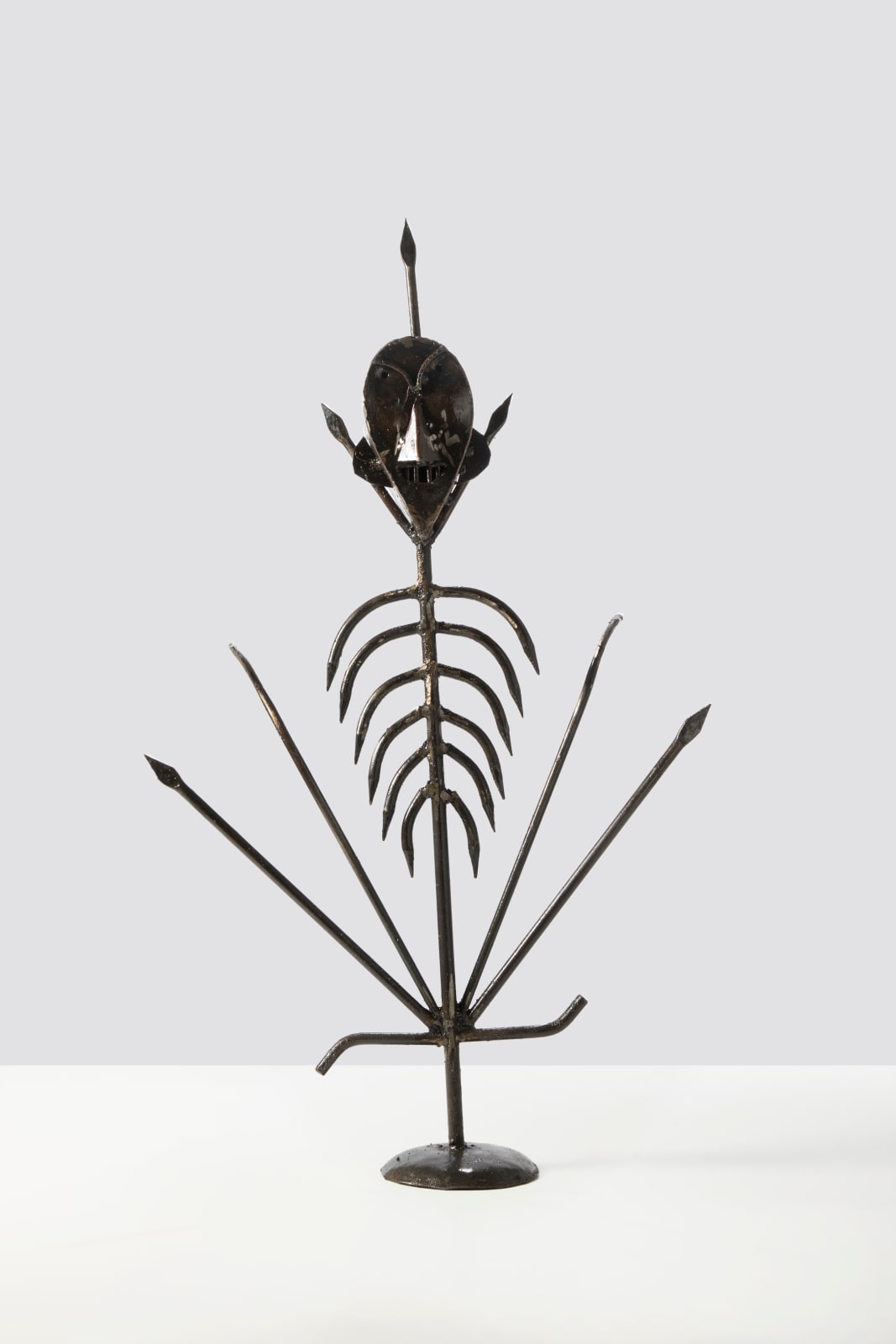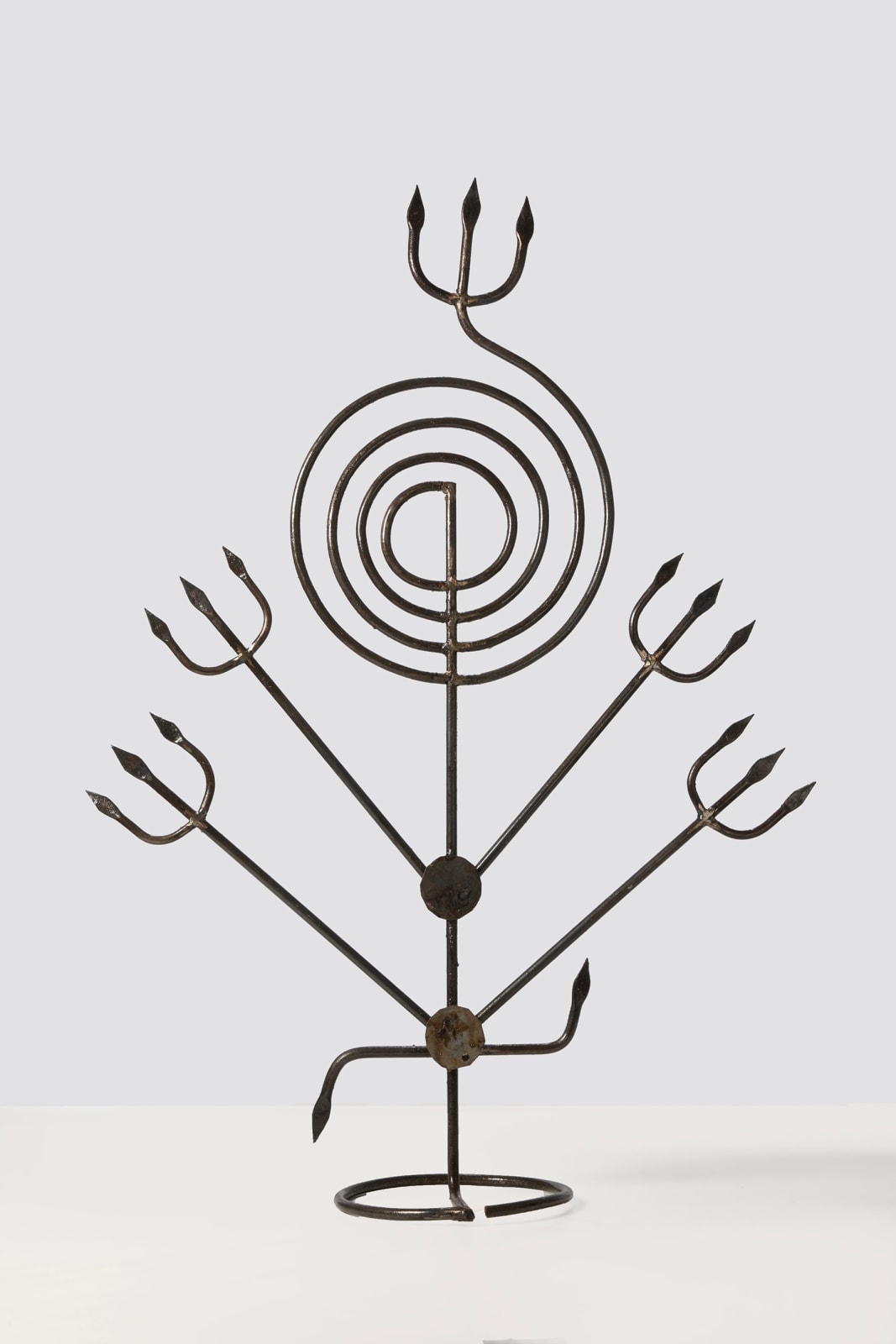José Adário
Art and craft are not separated in the trajectory of José Adário dos Santos (1947). Born in the neighborhood of Caixa d'Água, in Salvador, Bahia, at the age of 11 Adário began his work as a blacksmith of candomblé religious artifacts [ferreiro de santo], learning from his master and mentor Maximiano Prates at the workshop located on the historic Ladeira da Conceição da Praia, where Adário works until today. The Candomblé tools are iron sculptures that serve as a kind of mediation between men and the orixás, between the physical world - Aiyê - and the spiritual world - Orum - and are used in the “terreiros” (temples of Afro-Brazilian religions as Candomblé and Umbanda), in rituals and for devotion. For producing the tools with great formal sophistication and uniqueness, José Adário, also known as Zé Diabo, came to be recognized not only as the most celebrated blacksmith-sculptor in the candomblé temples of Bahia, but an artist whose practice is closely tied to the Afro-diasporic roots of his local culture – we must remember that Salvador is considered the blackest city outside of Africa.
The candomblé tools produced by José Adário are associated with different orishas that "work with iron", that have it as raw material – starting with Ogum, the warrior and master of technologies. Each tool deals, in a geometrized way, with signs and graphic aspects linked to the mythology of each entity. Exu, the first orisha in the pantheon of Yoruba deities, is the messenger between humans and the gods, the embodiment of the crossroads, and is evoked through shapes that reproduce the "crossed points" ["pontos riscados", sacred signs] of each distinct quality of the entity (Gira Mundo, Tranca Rua, Caveirinha), composed of tridents, spears, circles, etc. Ogum's tool, among its variations, will always have a bow from which agricultural tools will hang (axes, shovels, knives, sickles, spears, hammers, hoes, scissors), always in number 7 or its multiples. Oxóssi, the hunter, has as his greatest symbol the bow and arrow, his instruments. Ossain, the lord of herbs, will often have leaves and a bird at the top of his tool. Oxumarê, a term of Yoruba origin meaning "rainbow," is the orixá of cycles and transformation, and is often symbolized by one or more snakes surrounding the main stem of the sculpture.
The recognition of José Adário's work is not new. As early as 1968, the American art historian Robert Farris Thompson (1932-2021), a specialist in African-American art and culture, became acquainted with Adário's work while visiting the city of Salvador, incorporating it into his research. Thus, we can find mentions and analyses of Adário's sculptures in several books and articles, such as Icons of the Mind: Yoruba Herbalism Arts in Atlantic Perspective (1975), Flash of the Spirit: African & Afro-American Art & Philosophy (1983) and Face of the Gods: Art and Altars of Africa and the African Americas (1993). In all of them, Farris describes and relates the signs addressed by Adário to the iconography and liturgy of the Yoruba people, whose traditions were brought to Brazil by enslaved black populations from territories that are now countries such as Nigeria, Benin, and Togo.
Regarding José Adário's insertion in the Brazilian art circuit, it is largely due to the curatorial initiatives of the artist and curator Emanoel Araújo (1940-2022) from the 1990s on. Adário was part of some of the main exhibitions in which Araújo was able to gather and disseminate Afro-Brazilian art and culture, until then strongly neglected by our institutions. Among the shows are: Os herdeiros da noite - fragmentos do imaginário negro, Pinacoteca do Estado de São Paulo, 1994; Arte e religiosidade no Brasil: heranças africanas, Padre Manoel da Nóbrega Pavilion - Ibirapuera Park, São Paulo, 1997; and A África por ela mesma, Padre Manoel da Nóbrega Pavilion - Ibirapuera Park, São Paulo, 1998.
For Adário, working with iron means joining the lineage of Ogum descendants to which he belongs: his parents, grandparents, and great-grandparents all had some relationship with this orisha. And, Robert Farris Thompson explains, Ogum "lives in the flames of the blacksmith's forge, on the battlefield and, more particularly, on the cutting edge of iron." Thus, Adário's practice is a form of connection and reverence for the entity. Beyond technical skills, making the Candomblé tools requires sensibility in order to capture the desires of the orisha who will give life and energy to the artifact. It is as if the making of each tool comes from the desire of the entity itself to materialize in the world, and the artist, in this case, is the mediator, uniting the spiritual and material fields. Not by chance, José Adário is also considered a great babalorisha.
José Adário is the show that inaugurates Galatea's exhibition space and the artist's first solo show in the city of São Paulo. The show includes critical texts by Alana Silveira, producer and researcher from Bahia who has been following Adário for over three years, and Rebeca Carapiá, artist from Bahia who works with languages based on the handling of iron, and the exhibition design is signed by Tiago Guimarães. More than fifty sculptures will be presented, most of them created for the occasion, and will be accompanied by photographs by Adenor Gondim, a photographer from Bahia who has been portraying José Adário in the context of his studio for more than three decades.









